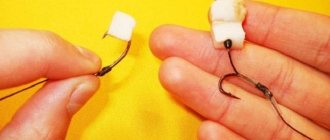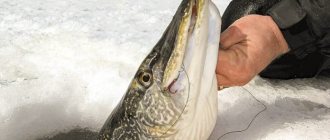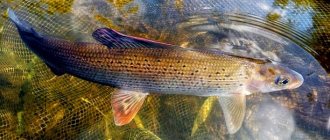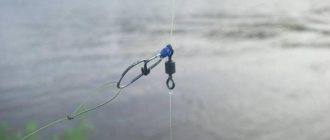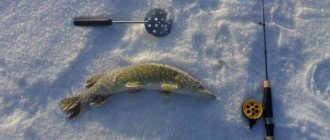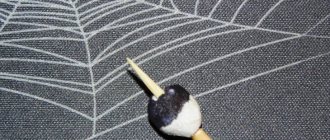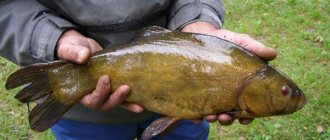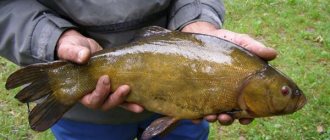Content
- 1 Description and lifestyle
- 2 Habits and habitats
- 3 Tackle and technique for catching burbot 3.1 Catching burbot with mugs and stands
- 3.2 Catching burbot on a donk
- 3.3 Catching burbot with a fishing rod
- 3.4 Fishing for burbot using a spinning rod
- 3.5 Catching burbot with a side rod
- 3.6 Catching burbot using girders
- 3.7 Catching burbot in winter using a snitch
- 4.1 Fishing for burbot in summer
Description and lifestyle
Burbot
The appearance of this fish is remarkable. It has a long snake-like body with a very large, wide and flattened head. The upper caudal fin and anus are very long and wide, like all cod fish. The body, covered with abundant mucus, has a color ranging from almost black in young fish to olive green with a marbled pattern in old burbots.
A characteristic feature is a single mustache adorning his chin. In this it differs from the catfish, which has two long whiskers on the upper jaw and four more on the lower jaw. By the way, catfish is a competitor of burbot and, apparently, displaces it from southern rivers.
In the summer, when other fish are actively feeding, the burbot hibernates, and in the winter, when other fish stand in the pits in a half-asleep state, the burbot is blissful and fattens.
Burbot
- cold-loving fish. The predator greatly respects cold water and feels excellent in the icy water of our northern rivers. In the rivers of the Russian North and in Siberia, it is not uncommon to meet real giants - up to a meter in size and weighing 20 kilograms. But the further you go to the south, the smaller and weaker the burbot; in the middle zone there are fish no larger than a kilogram. In Central Asia, Crimea and Transcaucasia you will not find this fish at all.
The way of life of burbot is still mysterious in many respects; not all features of its behavior can be explained. As already mentioned, this fish is northern. Prefers clean northern rivers with a hard rocky bottom, always with running water. In general, it feels great when the water temperature does not exceed 12 degrees Celsius. Well, when the water becomes warmer (in summer), burbot perceives this as a disaster, goes to shady places, hides in holes and under snags, and falls into a kind of hibernation. At the same time, it hardly feeds, leaving its hiding places only under the cover of night.
Another characteristic feature is their nocturnal lifestyle. The nocturnal predator, as a rule, spends the daylight hours in some kind of hidden shelter (snags, piles, holes in cliffs, shelters among roots), and goes hunting under the cover of night. Moreover, what is most surprising is that for his robbery he chooses darker nights, preferably moonless ones.
Moreover, his appetite wakes up in disgusting weather. Burbot likes to play mischief when the night is stormy with rain and wind - then the burbot is especially active. Why this is so is not fully explained, but burbot hunters know: the worse the weather, the better the burbot bite. Burbot bite best on nasty autumn nights - cold, windy, rainy, so this kind of fishing is not to everyone’s liking.
In winter, burbot is completely free. While most of the fish sleep or doze sluggishly in wintering pits in the winter cold, burbot does not waste time. Swims up to the half-asleep fish and eats it. Burbot eats up in winter and grows fat, taking advantage of the temporary defenselessness of most fish. He feels at ease and with impunity in the cold winter water.
It feels so good that in the middle of winter, spawning occurs in January and February. It spawns on a hard rocky-pebble bottom, or less often on a hard sandy bottom. Again, there is still some benefit from such early spawning periods for burbot: while other fish figure out what’s what, they begin to eat the burbot eggs, and the burbot fry will already hatch from the eggs and spread throughout the entire reservoir. Peak activity of burbot occurs in December, spawning in January.
By the third year of life it reaches sexual maturity. Young individuals contain up to 200 thousand eggs, more mature individuals - up to a million. Unfortunately, only a small number of eggs develop into full-fledged fish - they become food for adult burbot and other predators.
However, winter fishermen know that where burbot spawn there is always a lot of ruff, which means that the ruff loves burbot eggs. But in the spring, when other fish begin to spawn, the burbot fry are already right there. And the burbot itself is not averse to feasting on someone else’s caviar in the spring.
In summer, burbot goes into hibernation. As soon as the water warms up to 15 degrees, the burbot abandons its hunting activities and hides from prying eyes. You can meet him at this time in crayfish burrows near cliffs, as well as in snags, especially if there are springs with cold spring water nearby. He does not like summer heat; it makes the burbot feel unwell. It doesn’t go with fishing rods or donks.
Habits and habitats
From the description of the way of life it becomes clear that this fish is very, very peculiar. And it's not so easy to catch her. You need to study its habits well before you start fishing. Beginning fishermen, those who are planning to catch burbot, must first of all know the places where you can meet this mysterious fish.
Where can you find burbot? First of all, you need to find a place on the river where this nocturnal predator can live. Let’s try to define the concept of what a “burbot river” is. This river should not be calm; it is better when the water in it is fast and the bottom is rocky, pebbly or hard sand. It is important that the water is not muddy, but clean, and it is also important that the river flows in wooded banks, away from people and any pollution.
Burbot distribution map
Almost all rivers of the Russian North, many rivers of the Urals and Siberia meet these requirements. And in the middle zone there are not so many rivers that have not been developed by human economic activity, except perhaps small wooded rivers that cannot even be called rivers. That is why we have little burbot in the most famous rivers of the Middle Zone. And in the slowly flowing southern rivers, muddy or silted, there is nothing to look for at all. It does not tolerate pouring warm or stagnant water.
We found such a fast, cold river with a hard bottom, and even in a wooded area - then we need to look for places where a predator lives. Burbot is a more or less sedentary fish, that is, it searches for food not far from its camp sites, which is why it is so important to look for such “burbot places.” In rivers it prefers to settle near steep yars, especially if there are coastal crustacean burrows there, but also loves holes, especially if there are a lot of snags in the holes and there are icy springs.
You can find burbot under rafts, piers, under floating grass islands (in lakes), at great depths among rocks or on a hard bottom where there is some kind of shelter (rocks, cramps, bottom changes). On large northern lakes it settles under rocks at depths, and to feed it comes out to rocky elevations - “tables”, ridges.
In the fall, as the water gets colder, the night robber begins to “wander,” that is, it leaves its permanent camps and spreads out along the river in search of food. It especially “wanders” in cloudy, damp weather, mainly at night. Later, the burbot's travels become purposeful. In late autumn, flocks of burbot move up the rivers in search of spawning sites.
We must also take into account the fact that burbot is a bottom-dwelling fish. It looks for its prey mainly at the bottom; it goes out into shallow water extremely rarely and reluctantly, again under the cover of the edges. However, at the very core of the river, where the current is strong and there is nothing to “catch onto,” the burbot also has nothing to do. And it rarely rises to the surface, except at night during a thunderstorm.
Burbot is a predator, and a voracious predator. The basis of its diet is mainly fish, a variety of fish, most often bottom-dwelling fish - gudgeon, ruffe, goby, but by autumn, when many fish sink to the bottom, fish of various species can be found in the burbot's stomach. Young burbots are also predatory, but they most often get smaller food - worms, insect larvae, benthic organisms such as amphipods, fish eggs, crayfish, frogs.
The young burbot does not disdain the carrion that it picks up from the bottom. The main technique of burbot hunting is to slowly creep up to the prey and, with its mouth open, pull it into itself. This hunt is more passive than active, so burbot gets mostly sleepy, sick or inactive fish for dinner. In any case, burbot always prefers to take prey from the bottom. This feature must be taken into account and taken into account when fishing.
The best places for fishing on the Irtysh River
The Irtysh, flowing through the city, is decorated with backwaters, islands and bays. Nearby you can find pike, ide, burbot, crucian carp, carp, perch, and bream. If you get permission, you can catch muksuns, salmon or sturgeon. The current in the Omsk region is weak, the river in this area is wide and deep.
The distance from the city contributes to an increase in population and catch. Local fishermen prefer to use float gear baited with bread, worms, flies or fry. At the same time, bottom gear can bring a catch in the form of large bream.
Near the village of Tara there are several picturesque settlements, next to which there are plenty of fishing spots.
The village of Vagay is located in the Tyumen region. There is not much information about these places, but from recent sources it has become known that the catches here are not bad. Fishing for girders is especially good in winter. There is no end to pike.
Near the village of Tugalovo (Tyumen region), the Irtysh overflows, and there are islands in the middle of the river. If you manage to cross to the islands by boat, then you are lucky.
It is safe to say that the Irtysh is a fish river. No matter where you find yourself with a fishing rod in your hands, you will bring home a big or small catch. Good luck!
Tackle and technique for catching burbot
Catching burbot with mugs and stands
Setting up a burbot supply catching burbot anywhere is a waste of time.
The main thing is to find a burbot site or “trail”. This usually takes more than one day. Having set this goal, moored circles or stands are set up in specific places before dark. In all cases, the sinker and hook are lowered to the bottom. The line reserve is left no more than 1.0-1.5 m, so that the burbot does not take the tackle into the “support” or tangle it behind the stones. The distance from the sinker to the hook is 400-500 mm. If it is smaller, then not only the leash will end up in the fish’s mouth, but also the sinker along with the carabiner. It is best to take a single hook No. 12-14, double hook No. 7-8 or, as a last resort, a tee No. 6-7. The use of large tees is undesirable, since the burbot, feeling restless, can move the tackle into the shelter, and it is harder for live bait to swarm at the bottom with additional interference.
So what to do if there are no visible landmarks, but you have a strong desire to catch burbot? Unfortunately, this is technically difficult to do in open water, but it is nevertheless possible by installing supplies in appropriate fishing areas.
Very often, mugs for burbot have to be anchored when “white lambs” are walking on the pond. Under these conditions, unnecessary delay in installing them is not acceptable, since a sailing boat may overshoot the desired location.
When fishing in moderate winds, it is quite possible to catch burbot using circles, the design of which prevents the line from spontaneously coming off. Such a circle is anchored with the help of a sliding sinker weighing up to 30 g. Additional and time-consuming devices for anchoring the tackle are used only by beginning circlers. The length of the leash is set to at least 400 mm. And yet, for catching burbot, the most suitable is a universal, all-weather setup, in which the fishing line is fixed in the end slot, from which it can only be released with the help of a predator. This setup is ideal for fishing in the current. Depending on the strength of the current, the delivery dimensions and the weight of the cargo increase.
The stands are installed from the boat in the places where the predator is supposed to stay. If necessary, they can be examined at night, but, as a rule, they are checked only in the morning. The supply of fishing line on the fishing line should not exceed the depth of the reservoir, since the burbot, having swallowed the bait, rarely goes to the side for a long distance.
Catching burbot on a donk
Donka for spring burbot fishing: 1) peg;
2) guard bell; 3) main line; 4) leashes with hooks; 5) end sinker. Catching burbot on a donk is one of the most common methods of hunting a predator. This gear does not make any great demands. Burbot does not show much resistance when fishing, so a fishing line can be used that can withstand not the strongest hooks. The choice of the shape and weight of the load is determined by the flow of the reservoir in which the fishing will be carried out; homemade types are often used. The hook will fit with a long shank No. 2. This choice is due to the ability to reduce the likelihood of deep swallowing, and then fishing will be easier. Many experienced fishermen use homemade designs to unhook the hook in the dark. Burbot is often caught using live bait, frogs, and crawlers. More and more often, burbot is hunted using feeders and pickers. But still, the low popularity of this type of fishing is due to the small number of places where you can peck a predator. There are also cases of catching burbot using a spoon and live bait in a plumb line.
Burbot develops unprecedented activity in mid-October - early November, maintaining it until freeze-up. As a rule, it is at this time that the atmosphere is dominated by cyclones with precipitation in the form of rain and snow with frequent changes in pressure. That is, there is weather in which, as they say, a good owner does not let his dog go outside. However, it was precisely in this weather that burbots were caught on the same donks several times within an hour. Moreover, the best effect was observed when fishing with a running donka, as well as with a donka with a rubber shock absorber.
The “elastic band” is equipped with replaceable leashes that reach the bottom. If the burbot site is chosen correctly, and the angler wants to see the bite of a nocturnal predator with his own eyes, and he is not afraid of natural disasters (burbot does not take on a clear starry night), then fishing with an elastic band is just for him.
Catching burbot with a fishing rod
Winter donka for burbot Fishing for burbot is done with rods and shells close to the fishing rod, almost exclusively in winter, during spawning. Hunting fishing itself can be divided into spring, autumn and winter; In the summer, burbots are not caught with a fishing rod at all. Since this fish feeds only at night and walks along the very bottom, it can only be fished at night and from the bottom; At the same time, it was noticed that the darker the nights and the worse the weather, the better the burbot takes. On moonlit nights, as mentioned above, it bites poorly, also (at least in some places) on the new month; nevertheless, the fire of a fire or a lantern undoubtedly attracts burbot and improves their bite, so light is necessary not only for the convenience of the angler.
Fishing for burbot using a spinning rod
Although fishing with this gear at dusk is quite problematic, it is spinning that brings unexpectedly good results on summer nights. In practice, it has been noted that it is better to take a rod from 2 to 3 meters. The preferred test is 20-40 grams. As for the coils, any will do: both inertial and inertial. The main thing is that they are of good quality.
It is more effective to cast not from boats and boats, but from the shore. This is explained by the fact that burbot comes out to feed in shallow water, where the depth is no more than 2 meters. The best lures are oscillating and rotating. But you need to remember that these baits have the highest percentage of hooks. Therefore, you can use jig heads with hooks from #6 to #12, depending on the size of the local burbot. It is better to put foam fish on the hook rather than silicone baits. Why? It's all about a little trick. This fish is pre-soaked in the pulp of crushed live bait or fresh minced fish. Burbot, as you know, does not rely heavily on vision; it uses its sense of smell. This fish lasts for a maximum of 10 casts, then it needs to be soaked again.
Wiring must be done slowly. It is performed as follows. The cast is made, the fish should sink to the bottom. Then we make 3 turns of the coil and take a short pause. Then we repeat the maneuver. A pleasant bonus of this type of fishing is the frequent fishing of burbot and pike perch along with it. Instead of a foam fish, they also take live bait, but it doesn’t last long. It quickly loses its “marketable appearance”. In some places, good catches are achieved by hooking large crawlers on a jig head. But a small burbot goes after him. The weight of such “trophies” is up to 300 grams.
Catching burbot with a side rod
Design of an onboard fishing rod In addition to spinning, burbot can be caught using an onboard fishing rod.
But it is used at great depths, approximately 2-4 meters. To see the bite, place a glow stick or ball on the end of the nod. But not bells or bells, the noise scares the burbot. Take any reel, monofilament line, diameter preferably 0.2 mm. The sinker is a standard olive, the equipment is sliding. Live bait is chosen as bait. It can be any local fish - roach, gudgeon, ruff. The fishing technique is stepwise. The live bait is lowered to the bottom, then it is smoothly lifted 10 cm up and allowed to fall again. At the same time, the fisherman, being in his silent boat, drifts freely in the places where the burbot is supposed to live. A bite in most cases is expressed by a playful twitch of the nod and a weak pull. Despite the fact that this method is incredibly simple, it is the one that is most effective in places with pronounced depth. In addition to live bait, you can also use a jig head. Large worms, bird offal (liver), and pieces of fish meat are placed on it. The fishing technique is to periodically lower and raise the bait, tapping the bottom. Sometimes a simple foam fish soaked in minced meat or live bait pulp is also effective.
Catching burbot using girders
In addition to those previously described for catching burbot, you can use all designs of girders used for pike hunting. The differences are that there is no need for leashes, the placement of the nozzle 2-3 cm from the bottom or on it. For bait they use worms, dead fish, cut fish, etc.
The burbot's bite on the girder is very careful. It is worth hooking only after a clearly expressed stretch. Burbot is usually cast on a spoon at a distance of 15-10 cm from the bottom. In winter, spinners for burbot are light and wide, which move 35-50 cm to the side when lowered. First, the spoon is lowered and raised several times. Then they drop it to the bottom and pause for 5-15 seconds. Afterwards everything is repeated.
The most primitive trap for catching burbot can be made from a pole, a 1.5 m piece of fishing line (more than 0.40 mm) and a number 8-10 hook. A pole through the hole, with a fishing line tied to its lower part, is stuck into the bottom. Its upper end is above the ice. The cord with the nozzle on the hook is straightened by the current along the bottom. They use baits for burbot (under-ice girders) for fishing, which are frozen into the ice. They are a stick placed above and across the hole, with a small reel with a cord and fishing line attached to it. A weight is attached to the free end of the latter, and a leash (~1.0 m) with a hook is attached to the very end. In unsnarled areas, you can install vents equipped with an underwater forest clearer. There is enough fishing line with a margin of 1.5-2.0 m. Check the tackle with a wire hook from a hole drilled nearby. They also pull her to the surface.
Catching burbot in winter with a snitch
Catching burbot in winter with a snitch This gear is an active type and requires the fisherman to constantly move.
It consists of a winter fishing rod for burbot (suitable for trolling perch and pike-perch), monofilament fishing line 0.25-0.20 mm, a hook (horizontal spoon, jig head, sinker with a No. 10 hook on a winding ring or a specially cast sinker) . Crawling worms, dead fish (top swimmers, bleaks, minnows, sprat), sliced fish and meat (beef, pork) are attached to the hooks of the snitches. This tackle is a piece of metal of different sections (triangular, square, round), equipped with hooks on short leashes. Pieces of meat are placed on the hooks. The device is lowered to the bottom and then raised/lowered. The fish are attracted by the blows of the hammer on the bottom. The grip of the bait by the burbot is felt by a slight push.
Technique for catching burbot in winter using a hook: the nozzle with bait on hooks is lowered to the bottom. First, it is raised by 10...15 cm and lowered, then the amplitude is reduced to 3...4 cm. The fish is hooked only after the feeling of a pull.
Fishing techniques and tactics: tips and tricks
There are no fundamental difficulties in the process of catching burbot if you follow and observe a number of certain rules. In order to return home with a significant catch, it is recommended to consider the following tips regarding techniques and tactics for catching this predator:
- Artificial baits are not actually used for catching burbot, but you can try using them during winter fishing. To do this, you will need to choose models of spinners that are capable of sinking to the very bottom in a short period of time.
- There is a special fishing tactic called squinting . It is best to practice it in reservoirs where crayfish live, since burbots often settle down to rest in their burrows. A person enters the water up to his waist and begins to explore with his hands the space under the stones and snags, as well as all the depressions on the surface of the bottom. The secret is that burbot is calm about any touch and is not afraid of it, which allows you to pull it out of the water directly with your bare hands. Squinting is most often practiced in the summer when the weather is hot, when this predator loses any interest in food and is aimlessly in secluded places, escaping from unfavorable weather conditions.
- During winter fishing, special fishing rods are often used, which are installed on the coastline throughout the night. Small fish are usually used as bait for this fishing method; crucian carp or gudgeon are good choices. Additionally, on the shore you can light a fire or turn on a bright lantern, directing its light to the surface of the water. Despite the fact that burbot does not like high temperatures, it will very willingly move towards the alluring light.
- The process of fishing this predator out of the water is quite simple, since it practically does not offer any resistance. Therefore, you can carry out this process slowly, so as not to tear the line or prevent snags, and also help yourself with auxiliary tools, for example, a net.
- There is no need to hook prey , since this predator always deeply swallows the bait used. Usually, after fishing a fish ashore, the practice is to cut off the wire and then remove the hook.
Features of seasonal burbot fishing
Fishing for burbot in summer
Although burbot, as already mentioned, is a lover of the cold season and cold water, in some cases it can be caught in the summer.
One example of not very sporty, but sometimes very successful fishing is the search for burbot among the snags at the bottom, where it freezes in a daze in anticipation of the cold weather. A.P. Chekhov perfectly described this situation in his story “Burbot”. But even today, in many settlements, young fishermen actively use this method, pulling half-asleep burbots out of strong places. However, this method, with all its colorfulness, is problematic to call fishing in the full meaning of the term fishing.
But there are many places in Russia where burbot fishing is productive in the summer and with conventional gear in the summer.
The fact is that the activity of burbot depends on the water temperature. But in our country there are many reservoirs in which, even at the height of summer, the water temperature does not rise above 3-5 degrees. Mainly such rivers and streams can be found in the regions of the Russian North, in the vast expanses of Siberia. In such reservoirs, burbot remains active in summer, and you can catch it in the same way as in spring, autumn or winter. True, the activity of burbot at this time is still less great than in winter, and in order to become the owner of decent prey, you must be sure to find the burbot trail.
Burbot fishing in the off-season
Burbot biting schedule However, you can enjoy real burbot hunting only in the off-season - in the spring with the end of ice drift and before the first leaves bloom on the trees, and in the fall with clearing of the water and before freeze-up.
Let's start with the autumn period of burbot fishing, which is perhaps the most successful. It begins with the onset of the first light frosts. It is best to catch burbot at this time on completely dark nights, remembering that the nastier the weather, the better the burbot bite you can expect.
At this time, burbot is caught mainly with coarse blind equipment using the bottom method, or, simply put, with short donks, one and a half to two meters long. The end sinker on such a bottom is placed depending on the strength of the current. For bait you can use a wide range of baits. This could be, for example, live bait, if, of course, there is an opportunity to “get hold of”, which is extremely problematic at such a time, with several live fish. In some regions of central Russia, in small rivers, fishermen do the following: on the eve of burbot fishing, they go to the river with a shovel, go into the water with their boots on, and scoop up sand from the bottom onto the shore. In this sand there is a lot of river lamprey, or sand miner - the favorite food of burbot at any time. And they go out to the fishing itself at night, having a supply of lampreys with them. However, there is hardly any point in recommending such a fishing method - the fact is that the European river lamprey is listed in the Red Book of the International Union for Conservation of Nature in the category “Vulnerable Taxa”. And, although there is no direct violation of the law when catching European lamprey, the IUCN Red Book is only advisory in nature; it does not hurt to think about the future of the fauna of our rivers and lakes.
But let’s return to the baits used in late autumn for catching burbot. Many fishermen are more than confident that preparing live bait for catching burbot is too troublesome, and that burbot can be caught using much simpler baits. For example, using small fresh-frozen fish purchased in a store for this purpose. Successful experiments using thawed capelin to catch burbot have already been described. Also good results can be obtained from pieces of bird or animal intestines, pieces of animal liver (in this case, however, you will have to change the bait often so that it remains red), as well as piles of worms. Also suitable are frogs, zebra mussels, various insect larvae, leeches, and many other living creatures found in the river.
A very desirable attribute of burbot fishing in late autumn is a brightly burning fire on the shore. There is nothing surprising here, however. It is difficult to say for sure whether light attracts burbot, although many fishing authorities claim that light is an additional and very significant factor in successful burbot fishing. But the fact that in October or even early November it is impossible to spend a night fishing without a good fire does not require proof.
Burbot fishing is also successful in the spring, immediately after the flood. At this time, it is already possible to dig up earthworms in certain warmed areas of the earth, which we are very keen on. Often at this time, to search for and catch burbot, they use (where this is, of course, permitted) with hooks located at a distance of 4-6 meters from each other. This is the easiest way to find a burbot trail, and without much difficulty provide yourself with a sufficient number of burbots.
Fishing for burbot in winter
Fishing for burbot in winter After the formation of the first ice, the activity of burbot temporarily weakens, and resumes only after spawning, which usually takes place in late December - January.
The spawned burbot greedily grabs any bait at this time; the fish's feeding does not last long, but it is very effective. They fish at this time, as a rule, with winter baits, remembering that under no circumstances should you give too much fishing line to the burbot. In many Siberian rivers, during the winter feeding season for burbot, extremely simple gear is most often used to catch it. Many holes are drilled, a fishing line with a hook and bait on it is lowered into each, which is tied to a thick stick installed across the hole. To prevent the holes from freezing, a bunch of reeds or other grass that grows abundantly along the banks is squeezed into each hole. That's all - from time to time the fisherman walks through the places where the gear is installed and checks whether the burbot is sitting. If the hole still freezes, another one is drilled nearby, the main line is hooked with a special wire with a hook at the end and the gear is checked. If necessary, the bait is replaced.
In recent years, active gear has also been used to catch burbot on the ice - burbot is caught using lures. As a rule, large narrow white spoons, clearly visible in the water, are used as bait. The peculiarity of wiring is that after every three or four sharp swings and knocks of the spoon on the bottom, you need to pause for 10-15 seconds, while carefully watching the fishing line. At the slightest suspicion of a bite, you should definitely hook sharply.
It has long been known that burbot are especially attracted to the sound of the spoon hitting the bottom when trolling. Attempts by fishermen to use a wide, massive winding ring in the upper part of the lure, which, if successful, creates an additional knock on the bottom, have been successful. Perhaps it is this knock that attracts the predator.
Spoons can be with an ordinary soldered hook, like for pike perch, and winter spinners with a tee installed in the lower part on a winding ring. Using an ordinary hook, many fishermen put a dead fish on it, sometimes without a head. Flashing burbot is extremely exciting, if only because it is perhaps the only option for successful active fishing for this fish. True, it is worth saying that this method does not have so many adherents, be that as it may, and walking for a long time along a reservoir, tapping the bottom, is very tiring. We must also take into account that the best results are achieved by bad weather - a snowstorm, blizzard, drizzling rain, which is not very comfortable for the fisherman.
Burbot fishing: feeder fishing, snitch fishing, casting
Burbot differs from other freshwater predators in its mysterious way of life. This representative of the cod family spends its entire life at the bottom. The fish prefers cold water, so active biting is observed from late autumn to early spring. A distinctive feature of the burbot is a sensitive antennae on the chin, which helps the predator navigate in the dark underwater world. There are several ways to catch burbot, but first it is important to find the habitats of the nocturnal predator.
Habitats and search for places to catch burbot
Burbot is an amazing cold-loving fish. An interesting trend is observed: the further north and east the reservoirs are located, the larger the individuals that live in them. The trophy nocturnal predator is found in the Lena, Irtysh, Pechora and Ob, where the fish reaches a weight of 18 kg. It is futile to hunt for freshwater representatives of cod in the Aral Sea basin, in the Kuban and in the Caucasian rivers.
In the reservoir, burbot occupies areas with a silty and rocky bottom, where there is a slow current and cold water. The fish's favorite habitats are deep holes with springs. Loves burbot and shady places with running water.
Lure for catching burbot
Burbot is a typical predator, so it should be caught using animal bait. Sometimes this fish is caught using a spinning rod, but this gear is not suitable for targeted fishing. Only in winter can spinners boast of a good catch. The table shows the optimal bait for each time of year.
| Burbot fishing | winter | spring | summer | autumn |
| in stagnant bodies of water | sliced fish, worm, king prawn, dead fish | worm, ruff, fish cutting | crawler, dung worm, dead fish | frog, gudgeon, ruff, worm |
| on the rivers | worm, frozen herring, dead fish | ruff, goby, worm | leech, shell, lamprey larva, bait fish | lamprey larva, ruff, worm, crayfish meat |
Dead fish for catching burbot
Fishing for burbot at any time of the year is carried out in the bottom layer. This circumstance affects the choice of fishing method. Most often, anglers use several fishing options. Below in the table we will look at various methods of catching burbot and offer advice on when it is better to use one or another option.
Sinker for half-bottom for burbot
| Methods for catching burbot | half-bottom | bottom gear | zherlitsy | snitch |
In spring, half-bottoms are used for fishing from the shore. The fishing rod consists of:
The cast is made at a distance of 5-10 m from the shore, and the bait is worms or cut fish. | The most common method of catching burbot in open water is bottom fishing. Fishermen successfully use traditional baits or a modern feeder. Thanks to the presence of a feeder, it is possible to attract a predator with aromatic bait to the fishing site. | Catching burbot from under the ice is most often done using girders. A live or dead fish is placed on the hook, after which the equipment is lowered into the hole. In this kind of fishing, it is important to get on the burbot trail, then the catch will be excellent. | In winter, a special tackle called a snitch is used to catch burbot. This fishing method got its name thanks to a special spoon. The principle of fishing is to methodically tap the bait on the bottom, which attracts burbot from afar. You can put pieces of fish on the hook. |
Fishing for burbot in spring
Early spring is a good time to hunt for burbot. As soon as the ice melts, you should go to the reservoir. Burbot fishing is best done in muddy, cold water. As it warms up, the bite weakens, and the fish move to deeper waters.
The most suitable weather for spring fishing will be bad weather with low air temperatures. The predator comes quite close to the shore, moving along the riverbed edges. At the bends of the river you can fish right next to the bank. Burbot does not visit flooded meadows, “irrigations”, or thickets of last year’s vegetation. He picks up food carried by the stream of spring water.
Places to catch burbot in spring
Fishing for burbot in summer
Many fishermen confidently say that it is impossible to catch burbot in the summer. Indeed, the predator hides in deep holes at this time of year and rarely moves. But if you find such sites, then it is quite possible to tempt the fish to bite.
The behavior of burbot is significantly influenced by water temperature. Important: if the water warms up above +15°C, the fish becomes extremely passive. Therefore, burbot fishing in the summer is carried out in areas where there are underwater springs or cold streams flow into the reservoir. The phases of the moon also have a serious influence on the bite. Successful fishing occurs when the moon is waxing or waning.
Catching burbot in autumn
An excellent burbot bite begins in October, when the water cools down after the summer heat. Until the freeze-up, you can hunt for the single-whiskered predator. The best hours for fishing are in the range of 21-24 hours and 3-5 hours. The optimal conditions for a confident bite will be temperature changes and cloudy weather with light rain.
In the fall, you shouldn’t count on catching two burbot from one place. Therefore, the next cast after landing the trophy is made to a different point.
Catching burbot in autumn
Winter is considered the best period of the year for catching trophy burbot. This season marks pre-spawning and post-spawning feeding, and the water becomes the most comfortable for feeding the single-whisker predator. Calm days with an air temperature of -10...-15°C are best for fishing.
The fish is most active at night. That’s why fishermen set up their fishing rods in the evening and check their gear in the morning. During the Zhora period, there may be burbot on each fishing rod. It is possible to remove the hook from the fish using surgical clamps or after removing the entrails.
Winter burbot fishing
Choosing gear at different times of the year
Successful burbot fishing is possible only with the proper selection of gear depending on the time of year. Then it will be possible to pull out a predator with one antennae from the water. It’s enough to simply decide on a fishing rod, guided by the table.
| Gear selection | spring | summer | autumn | winter |
| stagnant bodies of water | half-bottom, elastic band | feeder, ring | elastic band, ring, feeder | zherlitsy, snitch |
| rivers | half-bottom, feeder | nook, feeder, ring | nook, feeder | zherlitsy, snitch, snitch |
Catching burbot with a hook
One of the old equipment for catching burbot is the zakidushka. As children, we made hooks for river fishing from a piece of rope 15-20 m long, with a heavy weight (50-100 g) tied to the end. 2-3 leashes made of monofilament 0.3-0.4 mm with a hook No. 3-4 were attached to the cord. Lamprey larvae (sandworts) were placed on the hooks and the equipment was thrown into the water. On the shore, the tackle was hidden under the bank, in the grass or in the bushes. In the morning we checked the traps; usually there was one small burbot on each of them. When baiting with live bait in order to increase the size of the trophy, frequent cutting of the leash by the pike occurred. By the way, this is why experienced fishermen recommend baiting dead fish. Snacks work best in late fall.
Catching burbot with a hook
Feeder fishing for burbot
The English donka is rightfully considered a universal tackle. It is excellent for catching burbot at night. The fishing rod consists of:
- rods 3.1-3.3 m long and 40-60 g test;
- “meat grinders” with spool 2500-3000;
- monofilament with a diameter of 0.3-0.4 mm or cord 0.12-0.15 mm;
- a leash made of nylon thread with a thickness of 0.20-0.25 mm;
- hook No. 2-3.
For river fishing, rectangular or triangular feeders are required, and in standing reservoirs you can use a model with any geometric shape. Installation of the feeder to the main fishing line is done using an anti-twist tube or Gardner equipment. A mandatory accessory when fishing at night is a firefly, which is attached to the top of the feeder.
Cuttings of worms, bloodworms, shells, pieces of fish, and chicken liver are used as bait. After filling the feeder, it is useful to treat the contents with an attractant with the aroma of worms, shellfish or squid.
Feeder fishing for burbot
Fishing with a snitch
An active method of catching burbot is snitching. It is used in winter to catch predators from under the ice. The gear requires the constant participation of the fisherman in the fishing process. It consists of:
- a winter fishing rod with a reel for vertical trolling of a predator;
- monofilament fishing line with a thickness of 0.20-0.25 mm;
- special spoon or jig head.
A worm, dead fish or cut fish is attached to the hook of the spoon. The bait sinks to the bottom, after which the reel is fixed. The game consists of raising the equipment to a height of 10-15 cm and then sharply lowering it. By hitting the bottom with a spoon, you can attract the attention of burbot. He approaches the fishing point and grabs the fragrant bait. The bite looks hesitant at first, and when the fish pulls the rig down, you should hook it.
Catching burbot at night
Important: when fishing, burbot often curls up its body, which makes it difficult to remove the fish from the hole. You shouldn’t force events; it’s better to use a hook when biting a trophy fish.
Burbot fishing is quite unusual and exciting. Night fishing is romantic, but you shouldn’t forget about safety precautions. The slightest careless movement can cause the fisherman to fall into cold water. Then you will have to end your fishing ahead of schedule.
dlyaribakov.ru

